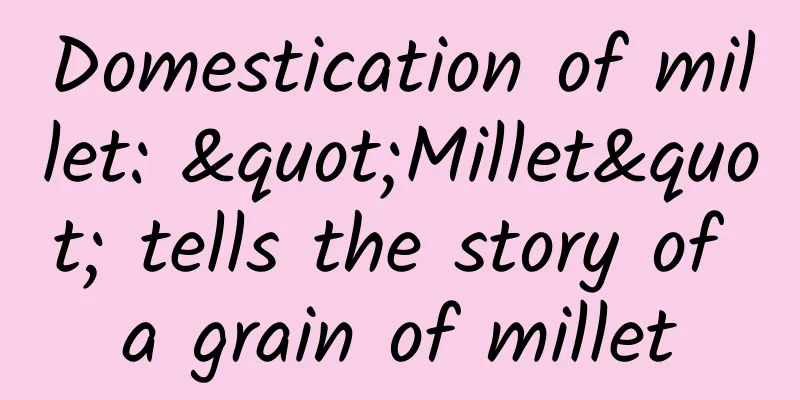Domestication of millet: "Millet" tells the story of a grain of millet

|
Millet is the most important food crop in ancient China, ranking first among the five grains. In the long era of agricultural civilization, the biggest dream of the Chinese people was peace and prosperity in the country and a good harvest of grains. Among the five grains, millet and sorghum were the first to be familiar to the Chinese ancestors. The "Ji" in Jiangshan Sheji comes from millet, and then refers to the grain god in charge of grain abundance. In the prehistoric Neolithic Age, the ancestors of the Chinese people had already begun to plant and eat millet and sorghum on a large scale. After thousands of years of artificial breeding and selection, China has cultivated a variety of millet crop varieties. The earliest wine and vinegar in China were brewed with millet. Thousands of years before wheat was introduced into China and rice crossed the Yangtze River into the Yellow River Basin, it was the native crops with husks such as millet and sorghum that nurtured the Chinese nation and nourished the Chinese civilization, eventually making the Chinese civilization one of the most brilliant ancient civilizations of the same era, and it has been splendid for thousands of years. It can be said that among various crops, millet has the longest and richest cultural connotation. The millet culture, a "gold mine" sleeping underground, is waiting for people to dig. Millet is commonly known as millet in northern China. After the seeds are shelled, they are called millet. Millet is drought-resistant and barren-resistant. To produce the same weight of grain, millet requires only 1/3 of corn, 1/2 of wheat, and 1/5 of rice. But today, millet is not the staple food of Chinese people. However, surprisingly, millet can be seen in almost all provinces of China. When did Chinese people start to grow millet? Why is this marginalized and minor crop so widely distributed in China? What secrets are hidden in it? The plow, invented in the Western Han Dynasty in the 2nd century BC, is the ancestor of the modern seed drill. The iron plow, ox-drawn plow and the plow are important contributions made by China to world agriculture. These great inventions were all born with millet farming. Yinxu unearthed the world-famous oracle bone script. The oracle bone script has a history of more than 3,600 years. In the oracle bone script, the character "禾" is the whole picture of a millet. And the character "米" in the oracle bone script looks like a grain ear full of grains. In 100 AD, the "Shuowen Jiezi" compiled by Xu Shen, a writer of the Eastern Han Dynasty, is the oldest dictionary in China. It gives a clearer interpretation of the character "米": 米, millet, is the shape of the grain. It means: 米 is the seed of millet, and the shape of the character looks like the shape of a grain. All these signs are revealing some secrets, that is, the influence of millet on China seems to be far beyond the imagination of ordinary people. In fact, there are as many as 50 or 60 unearthed remains of millet in China, distributed in more than a dozen provinces (autonomous regions) such as Hebei Province, Shaanxi Province, Henan Province, Gansu Province, and Inner Mongolia Autonomous Region, and most of them are concentrated in the Yellow River Basin. The Yellow River Basin is the origin center of Chinese civilization. Why did millet become the first choice for cultivation by Chinese ancestors? Is it native to China, or was it spread from abroad? The millet cultivated in my country was not introduced from abroad, but was domesticated from Chinese green foxtail grass. The Chinese ancestors discovered the natural variation of foxtail grass, and selected individuals with variations that are beneficial to humans, such as "large ears, no falling grains, and few tillers", and carried out special breeding to stably pass on these excellent traits. There is a big difference between foxtail grass and millet. Millet plants are tall, have few tillers, do not drop grains, have large grains, and have a lot of fragrance. The domestication of foxtail grass to today's millet has undergone thousands or even tens of thousands of years of change. It has gradually become a plant that does not drop grains. This domestication process has changed from many tillers to few tillers. In fact, it is a process of constant domestication and improvement. It has achieved a process from foxtail grass to farm varieties, and then to today's cultivated varieties. Image source: "The Story of a Grain of Millet" |
>>: Here's everything you need to know about ski jumping
Recommend
Tencent Advertising advertiser account opening qualification requirements!
Enterprise account opening qualification requirem...
There have been many electric vehicle fires recently. Do you still charge them this way?
recently Several fires caused by electric vehicle...
Is it okay to dump spent fuel and nuclear waste from nuclear power plants into the crater of an active volcano? What kind of black technology is ADS?
Nuclear power plants will inevitably produce nucl...
TikTok's fortunes take a turn for the better as Trump supports partnerships with Oracle and Walmart
[[342867]] September 20 (Sunday) was supposed to ...
Zhao Dongxuan's "50 Strategies to Make Traffic King"
Course Catalog├──1 . How to detonate customer traf...
Black hat SEO teaching video: Black hat SEO technical practical training video free online download!
When we are doing website SEO optimization, we al...
These pure milk samples failed the test! Excessive consumption may cause...
Recently, the Market Supervision Bureau of Qingyu...
The third phase of Naige's visual all-round class in May 2020 [full set of complete high-definition courseware]
Naige Visual All-Round Class 3rd Period May 2020 ...
VLC-based video player
I've been researching the video playback func...
Caimao Practice-The Fourth Period Documentation of Cat Brother System Learning Class + Leading Group
Caimao Practice - The fourth document of the Cat ...
How many statuses are there for Baidu bidding promotion accounts? What do they mean respectively?
Many friends who have just started working in Bai...
Promoting activation and retention: analysis of user growth system design
1. What is the user growth system? The evolution ...
HTC and Samsung in the past, Apple today: The unspoken rules that mobile phone manufacturers will understand only after the cold winter
On June 7, 1742, German mathematician Goldbach pr...
Is Baidu Port Account better or Baidu Framework Account better?
Is Baidu Port Account better or Baidu Framework A...
How can 5G mobile networks unlock advanced digital transformation?
5G connectivity is critical to facilitating the o...









